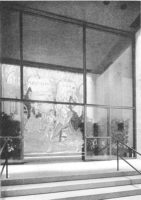Less is More to Restore at Mies' Tugendhat Villa

Tugendhat Villa
The first floor corridor of the Tugendhat Villa, built in 1930 and designed by Ludwig Mies van der Rohe for Brno, Czech Republic, includes more recently installed translucent glass panels that replaced the original design’s larger panels. A planned restoration would address such inaccuracies of previous restorations.

Tugendhat Villa
The lower floor’s conservatory frames one end of the main living spaces. Damage to the integrated heating system—a pipe for hot water running along the glass expanses to reduce condensation—is not as extensive as the villa’s structural problems.

Tugendhat Villa
The living and dining rooms on the lower level include sliding pocket glass window walls that automatically lower into the floor. The glass wall in the living room is not original, but still requires extensive renovation.

Tugendhat Villa
The basement of the Tugendhat Villa reveals a progressively designed mechanical ventilation system that allows for a so-called “economizer mode,” where untreated fresh air is pulled in from outdoors during good weather. The system can be shifted from cooling and heating mode to all outdoor air through a mechanical switch (not shown). Even by today’s standards, the system would be considered radical for residential architecture.

Tugendhat Villa
Although in need of extensive repairs, the lower level of Mies’ Tugendhat Villa still impresses with its open expanses of space and glass.

Tugendhat Villa
The lower level’s rear outdoor stair, leading to the sloped garden, reveals extensive damage. Furthermore, the travertine steps were clumsily replaced during a previous restoration, departing from Mies’ strict Modernist details.

Tugendhat Villa
An exterior elevation reveals the extent of the Tugendhat Villa’s disrepair, as the sloped site has caused the celebrated house to slowly pull away from its foundations.





